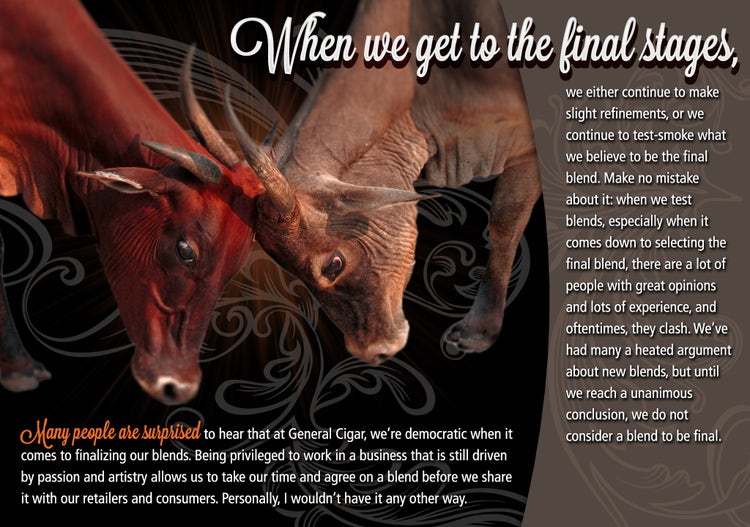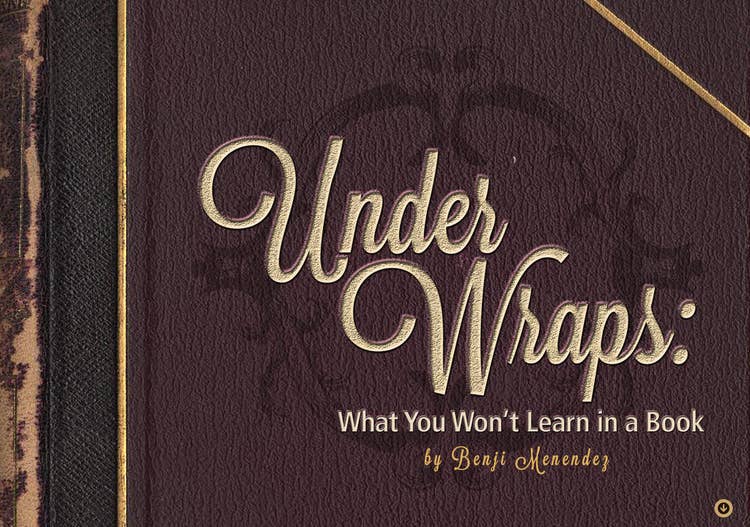
Under Wraps – with Benji Menendez
So much has been said of cigar blending over the years, and when speaking about blending, many people have made it sound like a very simple process. While I (Benji Menendez) am no expert at all things, not even after this, my 60th year in the cigar business, having grown up in Cuba on a tobacco farm, and watching my grandfather, father and uncles tend to the tobacco, i can tell you a thing or two about blending.
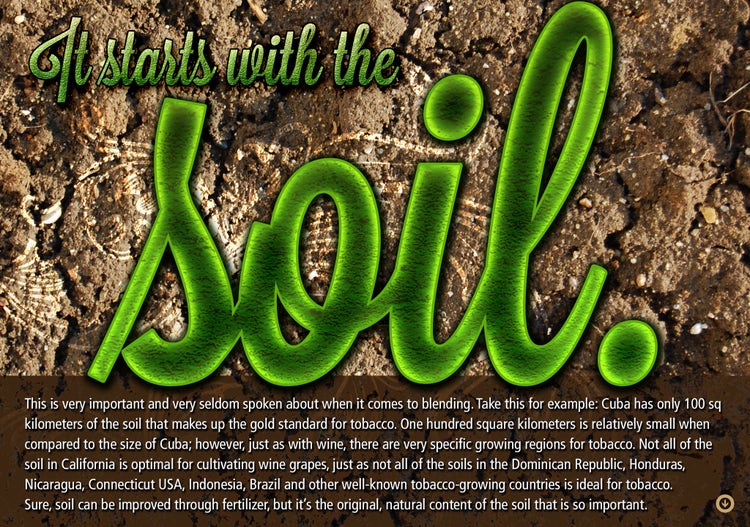
Some people believe that Cuban seed tobacco bears the characteristics of Cuban tobacco. That is not true. Cuban seed only gives a certain look to a cigar; it is the soil content that drives the flavor of the tobacco. So before you can even think about the types of tobacco you want to use in your blend, you have to start with the soil. Since the tobacco’s flavor comes from the soil, you have to analyze the soil before you even think about planting. Without getting too detailed, in order for tobacco to thrive and deliver what we want it to, we have to have the right balance of acidity and pH. If the soil is too acidic, the tobacco will not absorb the nutrients. When the plant does not absorb the nutrients, it llacks flavor. Fertilizer can be and is often used to improve the soil, but the soil cannot be made tobacco-friendly with just fertilizer. The soil has to be in the range of what’s ideal for tobacco before it can be used. Anyone who has tried to grow tobacco in the U.S. in their own yard can attest to this.
With tobacco, you have to be on top of it every day. Another very important aspect of tobacco blending comes into play before the process even begins. You may have a beautiful crop in the field but you can quickly ruin it by using improper processing, fermentation, and aging methods. With tobacco, you have to be in top of it every day. I often say that a cigar is a living thing before you light it. Just as you would not leave a child to grow on his own without caring for him, tobacco requires your full attention. Bringing all of the tobacco’s componants to a perfect fruition through processing, fermentation and aging is required before you can even begin to develop a great blend.
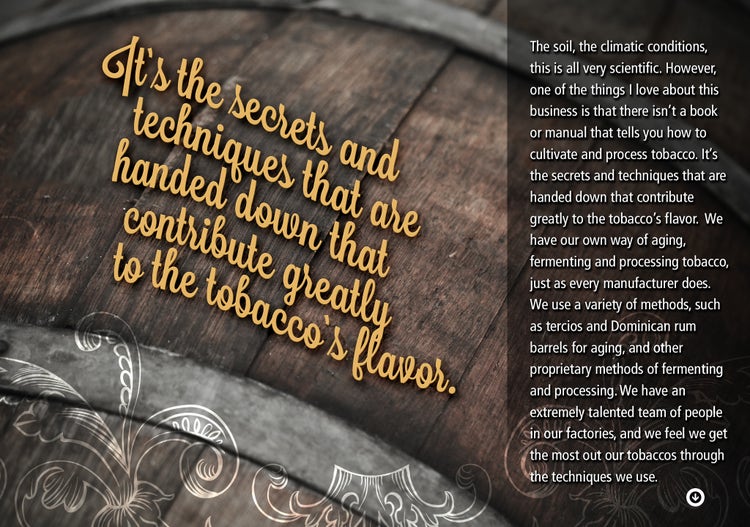
Now that we’ve ensured we’re working with tobacco from fertile soil that has just the right balance between PH and acidity, and once the tobacco is meticulously aged, fermented and processed, we can move onto blending. I like to say blending is like developing a recipe. You have to know the components first before you can make the recipe and deliver the flavor you’re targeting. Once you decide what flavor you want, whether it’s a strong cigar, one that’s mild and aromatic, or something between, then you are ready to start. People who blend tobacco have a knowledge base and a palate that they call upon when developing blends, just as a chef does when developing a recipe. Knowing the flavor profiles and strength of many varieties of tobacco is where it starts, but you still have to taste each tobacco individually. We traditionally pull a few leaves of the same tobacco together and smoke that single component to determine the overall taste. It’s like we’re confirming what our experience already tells us.
This doesn’t mean that we will stay with that exact tobacco for the blend, bit it provides a good jumping-off point. Once we decide on the type of tobacco we want to use, there is plenty of room for refinement. We play around with it. We use more or less of it, choose a leaf that’s higher or lower on the plant. The lower leaf on the plant, the less strength; the higher the leaf’s positioning, the stronger it is. There are some excellent wrapper, binder and filler tobaccos but just as with cooking, some ingredients don’t work together. With tobacco, there are some types that fight with each other and create a bad taste, so blending and refining is very important.
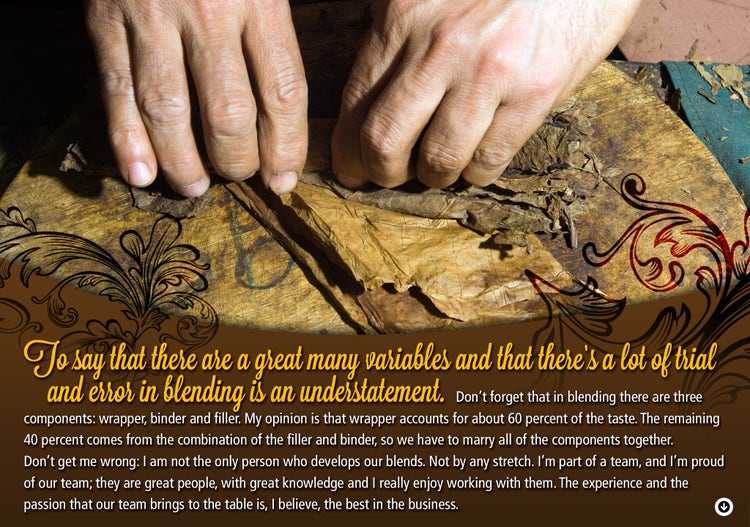
Once we arrive at a blend we like, we make several cigars of that same blend with those components and smoke them randomly. This is where a lot of people have seen me write directly on the cigar, because I don’t want to know what I’m smoking- I want a completely blind test for myself. Afterwards, I choose all the cigars I like and narrow it down to select what I believe is the best of the blends. Taste is subjective, so we don’t allow the opinions of just the people on my team to dictate the flavor of our new cigars. We have people in all areas of our company, tried and true cigar lovers that sample our blends and provide us with feedback. We often take it a step further by sending samples to members of our consumer testing panel to determine what they like about a particular blend.
It’s a matter of preference. Whenever I give someone a blend to test, I don’t like an absolute “yes or no,” on a cigar. This doesn’t give me any information. Instead, I want to know what the person likes or dislikes specifically because otherwise, I cannot come up with a cigar that pleases them. We all have different palates. I drink scotch; others like gin or rum. It doesn’t make anyone right or wrong, it’s a matter of preference. This is why it’s important for us to call upon our resources in developing our blends.
